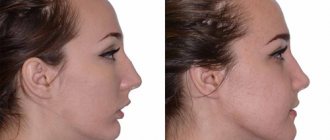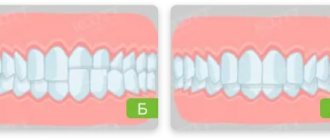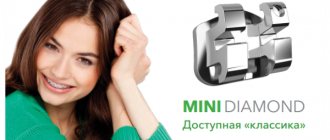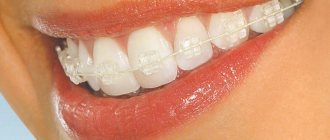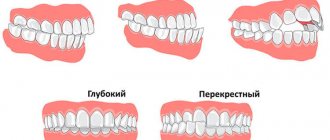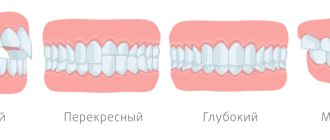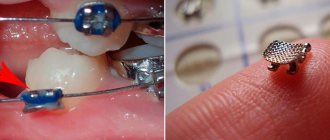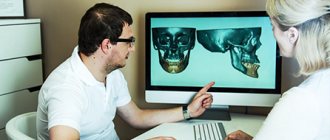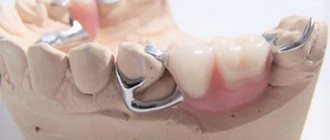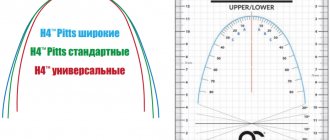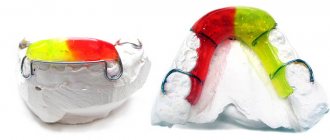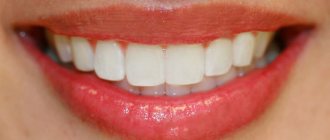For effective and high-quality orthopedic and orthodontic treatment for malocclusions of various etiologies, the use of special additional devices is often required. One of them is the facebow, which has two purposes: orthopedic and orthodontic.
An orthopedic face bow is a mechanical device that serves to develop the correct trajectory of jaw movement; it is also used to create a working model of the jaw and transfer it to three-dimensional space. The use of an orthopedic facebow is an integral part of high-quality prosthetics.
An orthodontic facebow is used as an additional structure when correcting malocclusions and is often combined with other orthodontic appliances.
Use of a facebow in orthopedics
The use of a facebow in orthopedics minimizes all inaccuracies and errors in the manufacture of prostheses.
According to the principle of operation, the face arc is divided into types:
Standard (medium anatomical) - consists of a U-shaped metal plate, which is fixed on the head using an ear or nose pad, and a bite fork, which is attached to the teeth (base wax is applied to it for an impression). The standard type of arch is applied to edentulous jaws for the manufacture of removable dentures.
Kinematic - such an arch is fixed at the point of the chin and the middle of the forehead line, allows you to get very accurate results, copies the correct position of the axis when moving the jaw, and is used in the manufacture of partial elastic dentures.
For greater efficiency, an articulator is also used, which allows you to reproduce the natural movement of the lower jaw.
Kotok R.Yu.
State Institution “Dnepropetrovsk Medical Academy of the Ministry of Health of Ukraine”
USE OF
THE FACIAL BAR IN ORTHOPEDIC DENTISTRY
The joint changes, as a rule, due to improper orthopedic treatment carried out without taking into account the peculiarities of the relationship of the dentition, which leads to arthritis, arthrosis, headaches, and discomfort when opening the mouth. The art of restoring the unique correct position of each tooth in the dental arch is based on the technique of using the facebow system and a custom articulator to determine and transfer individual facial landmarks.
The facebow
is a measuring template used to transfer the position of the plaster model of the jaw into the interframe space of the articulator relative to its opening axis as the dentition is oriented relative to the skull and condyles of the mandible.
The main reasons for the need to use a face bow in the work of an orthopedic doctor are:
— construction of occlusal planes in space;
- achieving a more successful cosmetic effect;
- the possibility of a more physiological construction of dental arches, since it is possible to check and straighten the sides, axes, inclination of the teeth and cusps relative to movement in the joints, along the lateral and incisal paths.
In 1887, Hayes designed a special device - a facebow, which allows you to determine the position of the model in the articulator relative to the articular mechanism. In 1899, GBSnow improved the facebow and introduced the Snow Acme articulator.
Dalbey (1912) proposed an anatomical arch that allows one to determine the position of the lower jaw relative to the base of the skull, taking into account craniometric landmarks - the horizontal plane and the Frankfurt horizontal. Many authors believe that such an arch design, which conveys the position of the lower jaw relative to the joint, makes it possible to reduce errors in the process of fixing jaw models into the articulator.
GG Campion (1902), JB Parfitt (1903), Gysi (1910-1912) also proposed measuring facebows to transfer data to a compatible articulator.
RL Hanau (1881-1930) also used a facebow and wax registers to fix the jaw relationships to adjust the articulator. McCollum H. Stallard, C.E. Stuart and co-authors (who founded the California Gnathological Society) used a complex gnatostatic device - a head cap with a system of special measuring arcs to record patient parameters. Modern systems include anatomical, facial, measuring, recording arcs and are divided into mechanical, as well as arcs that are part of electronic devices (virtual articulators).
Depending on the articulator, the archwire technique takes into account the Camper horizontal or Frankfurt plane so that the archwire is positioned on the patient's head parallel to the selected landmark. In addition to the listed landmarks, a prerequisite for a number of facial arch designs is the location of the arc parallel to the interpupillary line. In the clinic, the Kamper horizontal plane corresponds to the nasal axis, and the Frankfurt plane corresponds to the ear orbital axis.
When installing the upper jaw model into the articulator, the arch is installed parallel to the table plane, thereby aligning the landmark with the horizontal plane. After plastering the model of the lower jaw, taking into account the bite register, they begin to adjust the articulator. During the mechanical adjustment of the articulator, the inclination of the sagittal articular path forms an angle relative to the plane of the table and the established landmark. If the scale is oriented relative to the Camper horizontal, the line of closure of the jaw models cast in the articulator is approximately parallel to the plane of the table.
In articulators that take into account the Frankfurt plane, the plaster model of the upper jaw is tilted forward, the occlusal plane forms an angle with the horizontal plane that opens distally. Determining the basic parameters using a facebow requires its correct location. Teeth impressions obtained on a bite fork. Measuring stencils allow you to take into account the position of the head. However, the installation of the model is carried out taking into account one reference point: the Camper plane.
As a rule, a facebow consists of three parts: the arch itself (located on the patient’s head), a fork for obtaining impressions of the teeth of the upper jaw (models of the upper jaw) and a device that connects these parts, and with the help of a special lock that fixes the original position of the upper jaw.
Along with the position of the upper jaw, the face bow transfers the patient’s usual head position to the articulator, since the position of the molars of the upper jaw determines the position of the head. Thus, strict requirements are imposed on the position of the patient during registration, the materials used to obtain impressions, the quality of impressions of the upper jaw teeth, and the quality of impressions and jaw models.
The teeth marks on the bite fork should not be deep. They are obtained sequentially, starting from the front incisors, without strong pressure on the impression material located on the fork. Plastics and composites are also used for prints.
Methods of application
We will describe three ways to use a facebow:
Method 1.
In a mid-anatomical joint transfer, the approximate center of rotation of the condyle must first be found. It is located on a line connecting the outer corner of the eye with the apex of the tragus of the ear, approximately 13 mm. forward from the external auditory meatus. If you place the articular stop along these landmarks, then the error in finding the true axis of rotation of the mandibular condyle will be no more than 2 mm.
Method 2
. During mid-anatomical transfer from the external auditory canal, the articular support is first replaced with an ear support in the form of an ear olive. On the facebow and on the articulator, respectively, sockets must be made for mounting the arc, both from the joint and from the external auditory canal. The distance between these sockets should be calibrated at 13mm as described above.
Method 3
. The bite fork on the kinematic facebow is first attached to the lower dentition. Then, while the patient moves the jaw back and forth, opens and closes it; The dentist notes the movements of the knuckle point because the kinematic facebow knuckles have pointed pointers and their movement can be tracked more accurately.
Installation of a facebow along the external auditory canal is convenient and quick, which is why today it is the most commonly accepted method. The bite fork on the mid-anatomical arch is attached to the upper dentition, thus, the mid-anatomical transfer is the simplest approximate transfer of the position of the upper jaw and the transfer of the axis of rotation of the lower jaw to the articulator.
the Amann Girrbach
1 facebow
Material is applied to the bite fork to obtain an impression of the occlusal surface of the upper jaw teeth.
2.
A bite fork is inserted into the oral cavity and pressed against the teeth of the upper jaw. The bite fork is held until the material hardens completely.
3.
Installation of a facebow - ear pads are inserted into the external auditory canals.
4.
The facebow frame is connected to the bite fork using an adapter device.
5.
Fixation on the bridge of the nose.
6.
Clamp the position of the adapter device and the bite fork with the clamp.
7.
Installing the facebow orbital pointer
5.
Fixation on the bridge of the nose.
6.
Clamp the position of the adapter device and the bite fork with the clamp.
7.
Installing the facebow orbital pointer
8.
The universal clamp connecting the spoon and the face bow is released.
9.
The bite fork is removed from the mouth along with the transition device and the face bow is removed.
10.
The position of the spoon is transferred and the spoon is fitted using a universal portable table 11. The next stage is the position of the spoon is transferred and plastered using a portable table into the mounting laboratory articulator.
12.
In the laboratory, the model of the upper jaw is plastered on a tray, in spatial position to the upper base of the laboratory articulator.
What does the patient receive when the face bow is used adequately by a specialist:
— prosthetic work is more convenient and comfortable;
— prostheses do not require a long period of adaptation;
— there is a more effective restoration of the function of chewing and speech;
— the correct distribution of the load on the teeth is restored, which increases the service life of any orthopedic structure;
— the harmonious spatial arrangement of the frontal group of teeth relative to the position of the patient’s eyes, nose, lips and other anatomical features is realized.
Recently, many companies have been producing lightweight arch designs and fixing devices that allow the face bow to be positioned without any effort on the part of the doctor. The use of a face bow in the work of a dentist is a necessity, without which it is impossible to achieve satisfactory results in the work.
Literature:
1. Statovskaya, E.E. Application of a facebow when working with articulators / E.E. Statovskaya // LAB. 2008. - No. 1. - P. 51-53.
2. Clinical methods for diagnosing functional disorders of the dental system, / I.Yu. Lebedenko, S.D. Arutyunov, M.M. Antonik et al.//M., 2006.-111 p. 3. Khvatova, V.A. Occlusion and articulation in the practice of orthopedists and dental technicians. Part 6 / V.A. Khvatova // New in dentistry. 2001. - No. 1. -S. 43-56. 4. Bragin, E.A. Individual articulator / E.A. Bragin, A.A. Dolgalev // Current issues in orthopedic dentistry: collection of articles. scientific works Voronezh, 2000.-P.20-22. 5. Schwartz; A.D: Axioms of biomechanics. Some principles of orthopedic dentistry / A.D. Schwartz // New in dentistry. 2000. -No. 3. - P. 24-40.
Advantages
The use of an orthopedic facebow has a number of advantages:
- Installation of dentures is faster and the time spent visiting the dentist's office is reduced.
- The manufactured design is characterized by a high degree of wearing comfort.
- Thanks to the precise anatomical shape of the structure, the period of adaptation to it is reduced.
- Thanks to taking into account anatomical features in the manufacture of the prosthesis, chewing function is restored quickly and comfortably.
- The load on the teeth is correctly distributed, which increases the life of the prosthesis, as well as supporting teeth or implants.
- Good cosmetic effect and high aesthetics.
What does it represent?
This device in orthopedics and orthodontics has a different design, purpose and functionality .
An orthopedic facebow is a system designed to precisely position the relationship of the jaws in relation to each other and the center line.
The device allows you to obtain the most accurate data on the position of the jaws, which are subsequently used to form their working model and manufacture prostheses.
An orthodontic facebow is a design used to correct an abnormal bite. As a rule, a facebow is combined with a brace system.
Application of a facebow in orthodontics
The orthodontic use of a facebow is aimed at eliminating pathologies of the jaw structure and lack of space in the dentition.
The device is a curved arc consisting of two parts:
- Intraoral – the inner part of the arch is attached to support rings that are fixed to the teeth.
- Extraoral – fastening elements are fixed to an elastic bandage, which is fixed on the patient’s head or neck.
The following types of fixation exist:
- Fastening on the head – used to correct anomalies of the upper jaw, the bandage is fixed on the back of the head.
- Design with fixation on the neck – involves the elimination of defects of the lower jaw.
- Combined fixation – involves the simultaneous use of the head and neck, used for severe pathology of the dentofacial apparatus.
Advantages of using the device
The positive qualities of a facebow in dentistry are as follows:
- eliminating errors when modeling a bite on a prosthesis: previously, dental technicians received from the dentist only impressions of the jaws and a detailed description of the bite - and it was not always possible to create ideal dentures based only on these data,
- acceleration of prosthetics: since the patient does not need to come for frequent fittings, after which the prosthesis is sent for revision,
- manufacturing a comfortable, aesthetic and functional design,
- faster adaptation and restoration of diction after prosthetics,
- the chewing load is distributed more evenly along the row,
- extending the period of use of the prosthesis: because it is made in full accordance with the patient’s bite relationships, which reduces the risk of breakages - cracks, chipping or abrasion of artificial teeth,
- the smile looks harmonious: the teeth are aligned relative to the facial features (bridge of the nose, nose, chin).
Don't know what type of prosthetics to choose?
We will help in the selection, advise where to read more information and compare types of prosthetics.
Consultation with an orthopedic doctor in Moscow clinics is free! Call now or request a call
Working hours: from 9:00 to 21:00 - seven days a week
Advantages and disadvantages
The facebow in orthodontics is an effective tool in eliminating many anomalies in the development of occlusion.
The indisputable advantages of the face bow are:
- Relatively short treatment period (up to 6 months).
- Low cost due to the simplicity of the device and materials used.
- The ability to use the device at night without causing psychological discomfort (the design cannot be seen by strangers).
- High efficiency of the device, even in the most severe cases.
The disadvantages include the bulkiness of the design and fragile fixation, as a result of which the fastening element can jump off the support rings and injure the mucous membrane.
Indications and contraindications for installation
The decision to install a facebow is made by the orthodontist. Treatment with an orthodontic device is prescribed to patients:
- with an incorrect bite
- abnormalities of jaw development,
- displacement of dental units,
- crowded teeth.
A facebow is most effective in correcting malocclusions in children under 14 years of age while the skull bones continue to develop.
There are contraindications to wearing a metal structure:
- metal allergy,
- psychoneurological disorders,
- missing several teeth,
- inflammation of periodontal tissues,
- acute diseases of the oral cavity,
- arthrosis of the jaw joints.
If there are restrictions, doctors select other correction methods.
What you need to know when using a facebow
For high effectiveness of using the design, a patient who is prescribed a face bow should follow a number of recommendations. They consist of observing the following rules:
- Daily use of the device should not exceed ten hours.
- To eliminate pain and discomfort that may occur when moving teeth into the correct position, it is recommended to use painkillers,
- Before fixing the arch, it is necessary to carry out high-quality hygienic treatment of the structure and the oral cavity.
- The facebow should only be worn when at rest.
- During the period of use of the arc, the gums may become inflamed. In this case, to eliminate the causes of swelling and redness of the gums due to excessive pressure of the arc on the tissue, it is necessary to visit a dentist,
- If you use the arc while sleeping, you need to make sure that it is securely fastened.
Despite the bulkiness of the design, the face bow, when used correctly, is an effective orthodontic device.
Recommendations for patients
When undergoing a course of orthodontic treatment using a facebow, patients should adhere to certain rules:
- regularly visit the dental hygienist’s office to clean the surface of the teeth from bacterial plaque and deposits - at least 2 times a year. During the consultation, you will also be able to receive complete and detailed information on how to maintain oral hygiene during treatment,
- The device must be worn at least 10 hours a day. The course of treatment usually takes several months, but the exact duration will directly depend on the complexity of the pathology,
- if discomfort occurs while wearing the device, as well as the development of swelling and bleeding of the gums, you must immediately contact a specialist to adjust the tension force of the arc,
- Face bows should be removed when playing sports, otherwise serious injury may occur.
Important! Before installing the structure, you should make sure that the patient does not suffer from diseases of the soft tissues of the oral cavity. If inflammatory processes occur, before starting orthodontic treatment it is necessary to obtain permission from a periodontist.
It will also be necessary to eliminate the risk of developing allergies, and for this, a patient who has a history of rejection reactions will have to undergo examination by an appropriate specialist. It should be understood that standard orthodontic treatment may not be enough to eliminate serious pathologies of the mandibular joint. Often in such situations it is necessary to resort to the help of a dental surgeon.
Why are the arcs different in cross-sectional shape?
All arches for vestibular brace systems differ in thickness and cross-sectional shape. And this difference is important in the process of correcting the bite.
Arcs vary in thickness and cross-section
At the beginning of treatment, an arch with a circular cross-section is installed. She is the thinnest. It is inserted into the grooves of the bracket, which are rectangular on the inside. Therefore, the round arc does not completely fill the grooves.
The fact is that by the start of treatment, the patient’s teeth have been in the wrong position for 10–20 years or even longer (depending on how much time has passed since the formation of a permanent bite). Therefore, in the first month of treatment you should not exert too much pressure on them - this will cause great discomfort. First you just need to start moving your teeth.
The thinner the arch, the less space it takes up in the bracket grooves and the softer the effect on the teeth.
After 1–2 months of wearing braces, the roots of the teeth are already in a more mobile state. Many patients feel as if their teeth are loose. This is only partly true: the teeth do move, but the loosening is limited by the braces system and is not worth worrying about.
But now you can install a more rigid arch with a square cross-section. It fills the grooves of the braces more tightly, but still not completely. Square arches are used for several months during the main stage of treatment.
Square arch braces
At the final stage, it is the turn of the rectangular arc - the thickest and toughest. It completely fills the grooves of the braces, fixing the position of the teeth. This arch is put on when the desired result is achieved. Its function is to stabilize the teeth.
Braces cannot be removed immediately after teeth are straightened. You need to go through one more stage of treatment to consolidate the result. Patients go through this stage emotionally difficult: the teeth are already straight, but the braces are not removed and the arch is thick and noticeable. But this is necessary for complete treatment.
How much does the examination cost?
The cost of taking bite parameters using a facebow is difficult to separate from the total price of prosthetics, because it is not usually considered separately. After all, not only this, but also other devices are used for prosthetics: myographs, axiographs, articulators, etc. It is also necessary to take impressions - classical or digital - and take photographs of the face and X-rays. Without this, it is simply impossible to simulate an ideal smile and get a prosthesis that will feel like your own teeth in your mouth. If we take into account a comprehensive examination and registration of all parameters before prosthetics, then its cost can be 3000 rubles and 30 thousand - depending on the volume of the clinic’s capacities involved.
